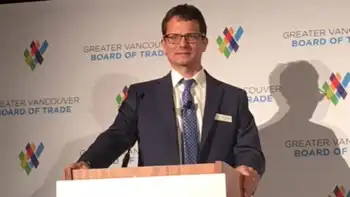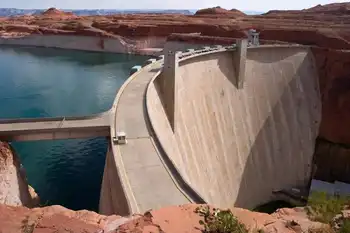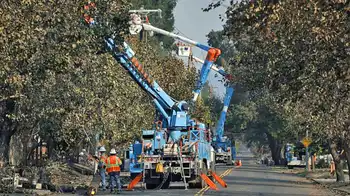PHILADELPHIA - - Engineers meeting in Philadelphia here for the first public technical session about the Aug. 14 blackout said recently that to avoid a recurrence, the industry should be more tightly linked, through mutual regulation and data sharing, though the path to that point was unclear.
The moderator of the session, Gerry W. Cauley, director for reliability performance at the North American Electric Reliability Council, a voluntary industry group founded after the 1965 Northeast blackout, said, "We can't go through another summer like this." But Mr. Cauley added that the August blackout did not occur on a peak demand day, and that a large-scale blackout like the one in August "can happen at any time." The engineers discussed whether their industry should have a system of peer review, like the one the nuclear industry uses, in which experts from various control rooms audit one another's workplace. Another idea at the daylong conference was better data integration, so the technicians who operate transmission systems could see trouble brewing in their neighbors' territory. "You need it for the area that you could affect and the area that could affect you," said Don Watkins, a transmission expert at the Bonneville Power Administration, which operates federally owned hydroelectric installations and transmission lines in the Pacific Northwest. A report on the blackout by a Canadian-American task force, many of whose members gave presentations recently, found that two Midwestern entities, the FirstEnergy Corporation and the Midwest Independent Transmission System Operator, had violated the existing voluntary rules. A representative of the Midwest system operator said his group was taking steps to improve its operations by the end of the year. Federal officials and industry executives have anticipated better regulation through action by Congress, which has discussed authorizing federal regulators to impose mandatory reliability standards. That idea is popular in Washington, but the legislation to establish them was incorporated into a mammoth energy bill that so far has failed to pass the Senate. A similar approach also failed in 2002. The provision in the energy bill would have allowed the Federal Energy Regulatory Commission, which is mostly an economic regulator, to designate the North American Electric Reliability Council to set reliability rules. But now, Mr. Cauley said, the industry should proceed "with or without Congress." The chairman of the commission, Pat Wood, took a similar position earlier this month and asked his staff to investigate whether the agency already had the authority that could be used to enact such standards. But the problem, engineers agreed, extends far beyond setting standards, to actually instituting them. "We're going to need some monitoring mechanisms in place," said David W. Hilt, the director for compliance of the North American Electric Reliability Council. The goal, Mr. Hilt said, was to "assure we really do implement the recommendations." Marjorie R. Philips, director of market policy at P.S.E.G. Energy Resources and Trade, an affiliate of a company that provides electricity and gas in New Jersey, said it would take more than monitoring. "If there's no consequence, you have not done what you set out to do," she said. For violators, she suggested monetary penalties or "public shunning." The industry has not even standardized the method for calculating how much electricity a line can carry, said Tapani O. Seppa, president of the Valley Group, a consulting firm in Ridgefield, Conn. On Aug. 14, FirstEnergy was assuming a wind of 4.4 feet per second, he said, but actual conditions in much of its territory were dead calm. Without any cooling from wind, the cables would be 40 to 100 degrees Fahrenheit higher, he said, and would sag more, leading to cables hitting the trees. Tree contact for a fully loaded line is equivalent to "two or three sticks of dynamite," Mr. Seppa said. On that day, 23 percent of weather observations in the area were showing a wind speed of zero, he said.
But Mr. Cauley added that the August blackout did not occur on a peak demand day, and that a large-scale blackout like the one in August "can happen at any time."
The engineers discussed whether their industry should have a system of peer review, like the one the nuclear industry uses, in which experts from various control rooms audit one another's workplace. Another idea at the daylong conference was better data integration, so the technicians who operate transmission systems could see trouble brewing in their neighbors' territory.
"You need it for the area that you could affect and the area that could affect you," said Don Watkins, a transmission expert at the Bonneville Power Administration, which operates federally owned hydroelectric installations and transmission lines in the Pacific Northwest.
A report on the blackout by a Canadian-American task force, many of whose members gave presentations recently, found that two Midwestern entities, the FirstEnergy Corporation and the Midwest Independent Transmission System Operator, had violated the existing voluntary rules. A representative of the Midwest system operator said his group was taking steps to improve its operations by the end of the year.
Federal officials and industry executives have anticipated better regulation through action by Congress, which has discussed authorizing federal regulators to impose mandatory reliability standards. That idea is popular in Washington, but the legislation to establish them was incorporated into a mammoth energy bill that so far has failed to pass the Senate. A similar approach also failed in 2002.
The provision in the energy bill would have allowed the Federal Energy Regulatory Commission, which is mostly an economic regulator, to designate the North American Electric Reliability Council to set reliability rules. But now, Mr. Cauley said, the industry should proceed "with or without Congress." The chairman of the commission, Pat Wood, took a similar position earlier this month and asked his staff to investigate whether the agency already had the authority that could be used to enact such standards.
But the problem, engineers agreed, extends far beyond setting standards, to actually instituting them. "We're going to need some monitoring mechanisms in place," said David W. Hilt, the director for compliance of the North American Electric Reliability Council. The goal, Mr. Hilt said, was to "assure we really do implement the recommendations."
Marjorie R. Philips, director of market policy at P.S.E.G. Energy Resources and Trade, an affiliate of a company that provides electricity and gas in New Jersey, said it would take more than monitoring.
"If there's no consequence, you have not done what you set out to do," she said. For violators, she suggested monetary penalties or "public shunning."
The industry has not even standardized the method for calculating how much electricity a line can carry, said Tapani O. Seppa, president of the Valley Group, a consulting firm in Ridgefield, Conn.
On Aug. 14, FirstEnergy was assuming a wind of 4.4 feet per second, he said, but actual conditions in much of its territory were dead calm. Without any cooling from wind, the cables would be 40 to 100 degrees Fahrenheit higher, he said, and would sag more, leading to cables hitting the trees. Tree contact for a fully loaded line is equivalent to "two or three sticks of dynamite," Mr. Seppa said.
On that day, 23 percent of weather observations in the area were showing a wind speed of zero, he said.
Related News

Two new BC generating stations officially commissioned
VANCOUVER - Innergex Renewable Energy Inc. is celebrating the official commissioning today of what may be the last large run-of-river hydro project in B.C. for years to come.
The project – two new generating stations on the Upper Lillooet River and Boulder Creek in the Pemberton Valley – actually began producing power in 2017, but the official commissioning was delayed until Friday September 14.
Innergex, which earlier this year bought out Vancouver’s Alterra Power, invested $491 million in the two run-of-river hydro-electric projects, which have a generating capacity of 106 megawatts of power. The project has the generating capacity to power 39,000…




